North American Harvard

Overview
Overview
The North American Harvard is another famous and highly successful design. Also known by a wide variety of other names (Harvard, Texan, Yellow Peril) or designations (AT-6, T-6, etc), the aircraft was heavily used by the Royal Air Force and Royal Canadian Air Force during the British Commonwealth Air Training Plan in the Second World War and subsequently for NATO pilot training in the post-war era. Approximately 11,000 Canadians and 8,000 Allied airmen received pilot training on Harvards in Canada during the Second World War. The aircraft could also be modified as an armament trainer capable of carrying either machine guns, rockets or practice bombs.
| Designation | |
| Model Number | NA-66/76, T-6 |
| Marks | Mk I, IIA, IIB, III, IV |
| Role | Trainer |
| Taken on strength | 1939 |
| Struck off strength | 1965 |
| Number | 2,258 |
| Service | RCAF / Royal Canadian Navy |
|---|
Source: Canadian Combat and Support Aircraft: A Military Compendium by T.F.J. Leversedge © 2007. Translated and reproduced with permission of the author.
Technical Specifications
Technical Specifications (Mk IV)
| Manufacturer | Canadian Car & Foundry Ltd under license from North American Aircraft |
| Crew / passengers | Two pilots |
|---|---|
| Powerplant | One 600 hp Pratt & Whitney R-1340-AN-1 Wasp radial engine |
| Maximum speed | 180 miles per hour (290 kilometres per hour) |
| Cruising speed | 140 miles per hour (225 kilometres per hour) |
| Service ceiling | 22,400 feet (6,827 metres) |
| Range | 750 miles (1,207 kilometres) |
| Empty weight | 3,995 pounds (1,814 kilograms) |
| Gross weight | 5,235 pounds (2,376 kilograms) |
| Span | 42 feet (12.81 metres) |
| Length | 28 feet 11 inches (8.8 metres) |
| Height | 11 feet 8.5 inches (3.55 metres) |
| Wing area | 253.7 square feet (23.57 square metres) |
| Armament | Provision for machine guns, rockets and practice bombs |
| Cost | $27,000 USD |
Source: Canadian Combat and Support Aircraft: A Military Compendium by T.F.J. Leversedge © 2007. Translated and reproduced with permission of the author.

